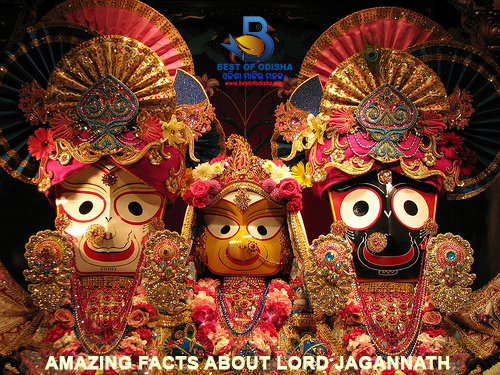Lord Jagannath is not only considered as a Hindu GOD. His devotees include personalities of all religions, casts and races. Bhakta Salabega being Muslim was one among the most eminent devotees of Lord Jagannath, Mohammed Shikandar Alam is famous for Lord Jagannath Bhajans. Behind the main temple inside Sri Jagannath Temple Complex, there is another significant small replica of the whole temple. There is a huge Cross installed at the rear of the temple evidence to Lord being visited by Jesus Christ. Budha had been a great devotee of Lord Jagannath, Even Lord Jagannath had been the most admired god for Guru Nanak.
The present day God Lord Jagannath originally manifested in Purusottama-kshetra “Nila Kandara” as a giant sapphire gem stoned avatar called “Nilmani” or vigraha named “Neelamadhava”.
Daily 88 types of Bhog are prepared in different phases, on special occasions and during festivals the number of items increases.
The Bhogamandapa in Sri Jagannath Temple, Puri was originally a part of the Konark temple complex. It was dismantled and reassembled by the Marathas in the 18th century. Amazing but true.
Abadha : the mysterious prasadam of Lord Jagannath has such unique name as it is never served, it is made using earthen soiled pots kept one over the other on an earthen furnace….. amazingly the topmost pot being cooked first and then the next below. Believe it or not.
The Sri Jagannath Temple at Puri and all surrounding structures inside meghanada pacheri are not made at the same time. History shows that the three parts of the temple are also made during three different times by several rulers as per the time demanded. the meghanada pacheri was made by Marhatta rulers to protect the temple against tough see waves. All other miscellaneous temples in the bedha are made during various periods by several rulers.
The Jagannath temple kitchen at Puri is reputed to be the largest kitchen in the world, with 400 cooks working around 200 hearths to feed over 10,000 people each day.
Garuda Stambha : The 16 sided monolithic pillar measuring 11 meters in height .Originally it was not there at Sri Jagannath Temple Puri. It stood in front of the famous Sun Temple at Konark and in the 18th century Marathas when ruled Odisha they dragged the Garuda Stambha thru sea shore till Puri Jagannath Temple.
Present day structure of Sri Janagnnath Temple Puri was not the Original built up. Originally Indradyumna had constructed only the main temple. Kings and rulers in subsequent times added Meghanada Pacheri, Mukha sala, Nata Mandapa and other assets to the Temple Complex.
Lord Jagannath was discovered by a clever Brahmin named Vidyapati who was blindfolded to visit the lord’s cave in a dense forest but could managed to retrace the path by sprinkling mustard seeds on his way and with the help of king Indradyumna he managed to vanish with the GOD.
Chariot Festival at Puri was initially performed with 2 sets of chariots ( A total of 6 Chariots ). As there was a river flowing thru in between Sri Mandira and Mausi maa temple, the first set of chariots were used to bring the lords till the river, then lords had to ferry across the river in three giant wooden boats and aboard the other set of chariots till Mausi maa temple. Amazing but true.
Garva Muda, the most mysterious part of the temple is said to have storing the precious jewelleries of the Lord, protected and secured by venomous snakes and heavenly divine souls.
Ratna Muda is the top portion of the temple structure…. that has a miraculous magnetic power within which stabilizes and sustains the electromagnetic changes and forces acting upon it due to the geostationary location and erection.
About King Indradyumna found a mysterious old Brahmin carpenter who requested responsibility of carving lord’s figure on a wooden log, but insisted that he would not be disturbed while he was carving the deity. After 7 days and all sounds stopped from the room, king force opened the room to discover the old man missing and GOD half made.
Madala Panji: Madala – Panji was recorded in the Telugu Language & preserved in the Manuscript Library in Madras, which speaks about the story regarding image of Nila Madhaba of Udra – desa (Odisha). It seems to have written during 14th century when the king had newly installed the images after destruction made by Kalapahad. The Puranic persons like Narada, Brahma etc. are found to be associated with the story, for which it cannot be taken as a reliable history of the origin of Jagannath. The name of king ‘Indradyumna’, who was supposed to be a worshipper of Vishnu, is not found in Madala – Panji. Therefore, it can be taken as puranic rather than
historical document. After the death of last independent king Mukundadev, Kalapahad invaded Odisha & burnt the sacred wooden deities near river Ganga. After this the Delhi Emperor sent Manasingh to keep tranquil & peace in Utkal, during the region of Bhoi king Ramachandra, who inherited the ‘Gajapati’ title of Odisha. He organized the ‘Navakalebar’ for the second time by newly installing the images made of wood & then called ‘Daru – Brahma’ & most probably he had appointed a ‘Karan’ to write the daily affairs of Lord Jagannath in a ‘Panji’, which was being kept in the shape of ‘Madala’ (Drum); thus that sacred temple record was called by the name “Madala – Panji”
0











